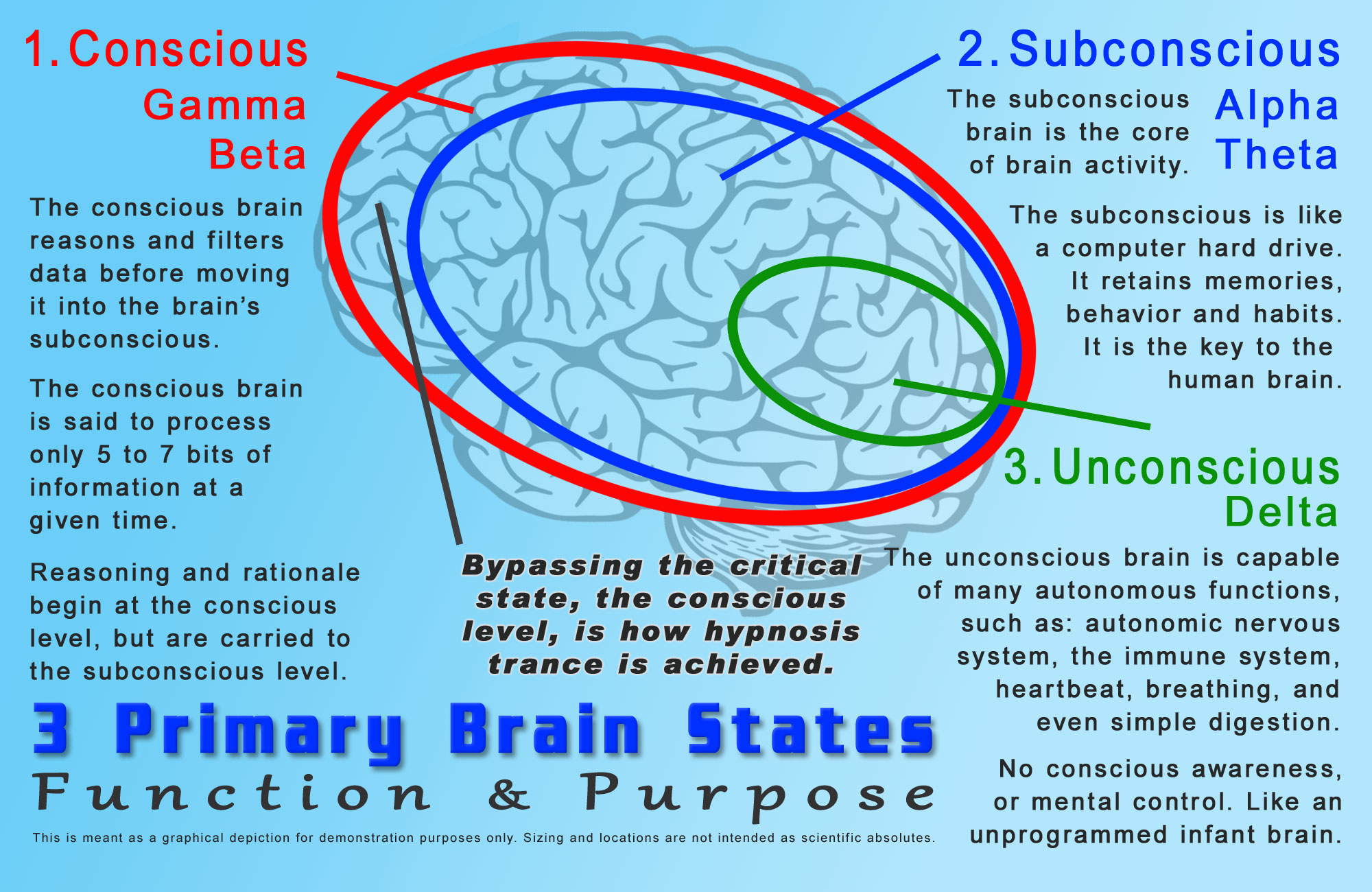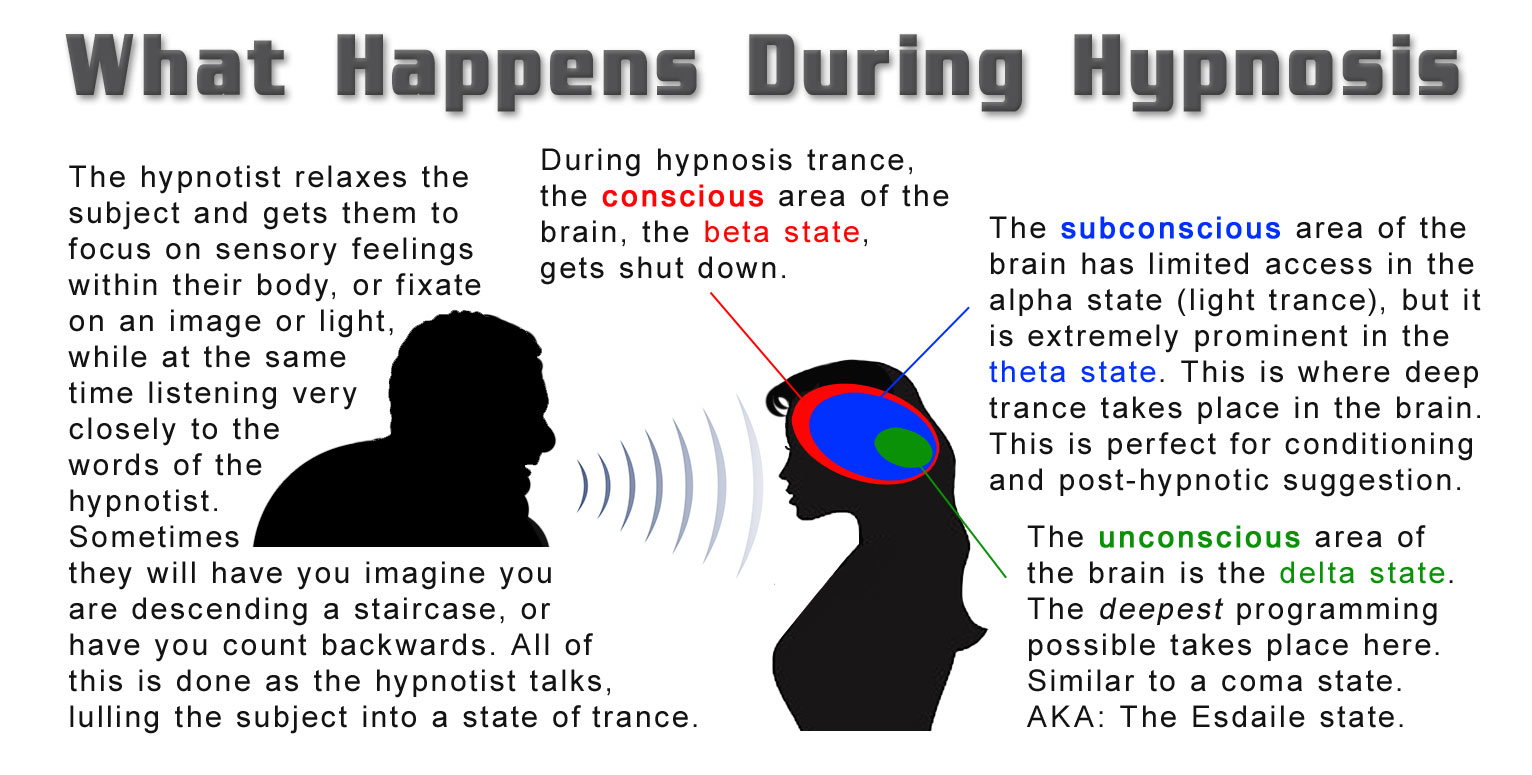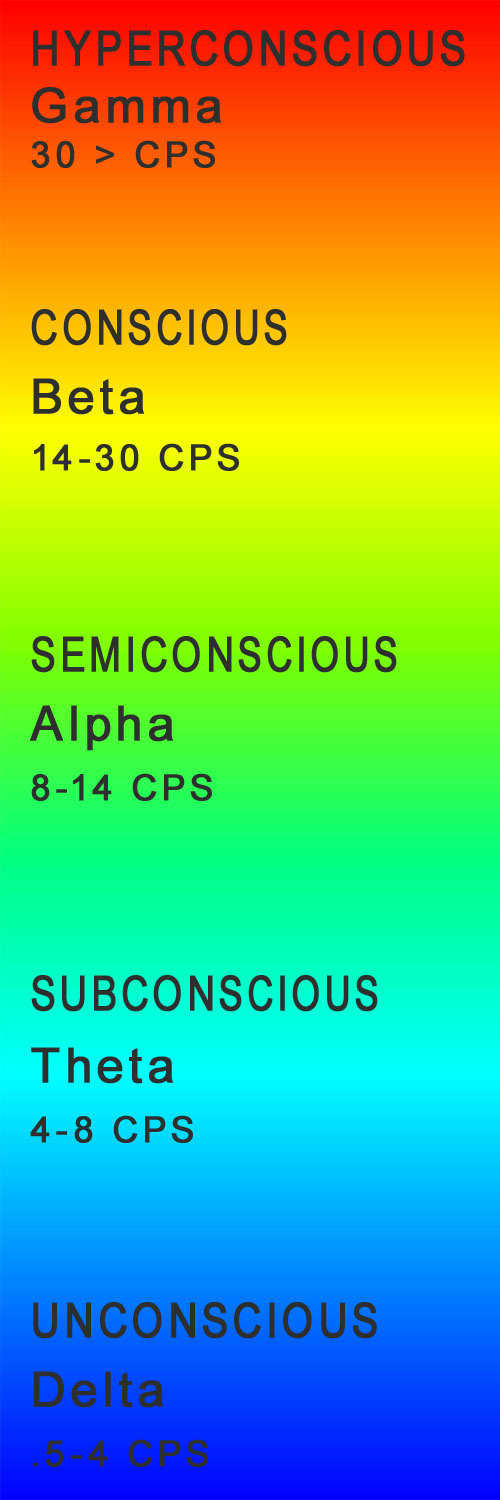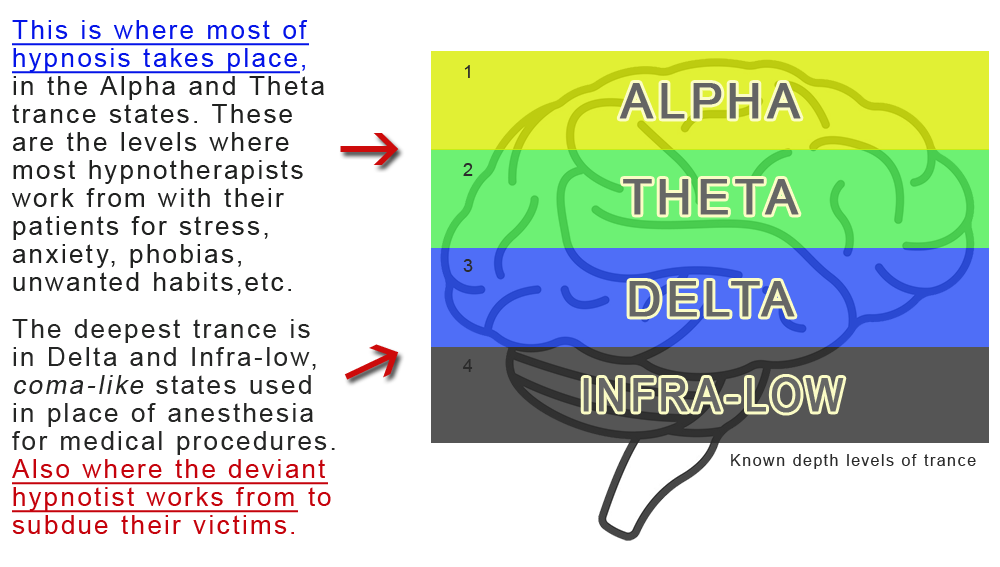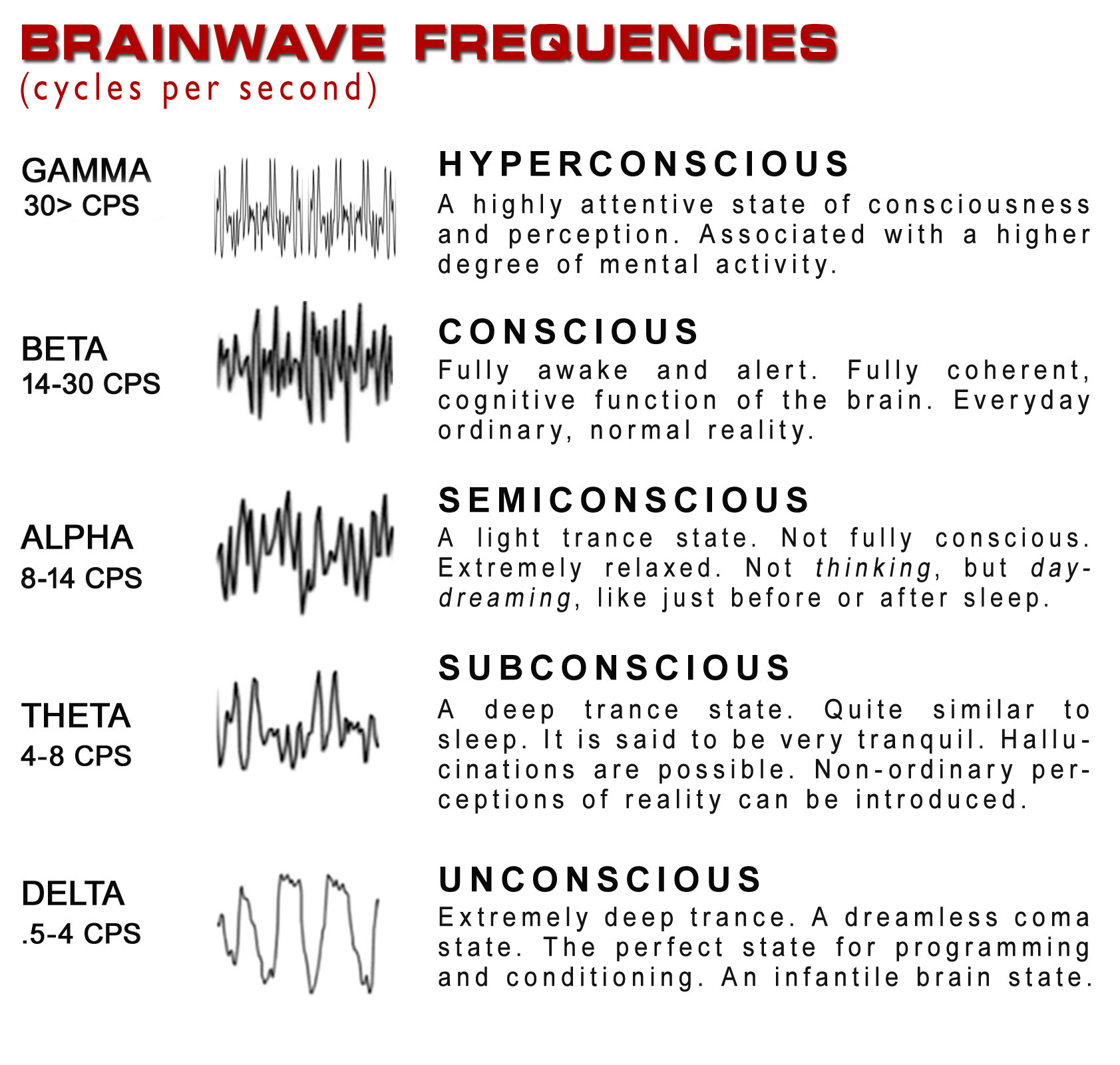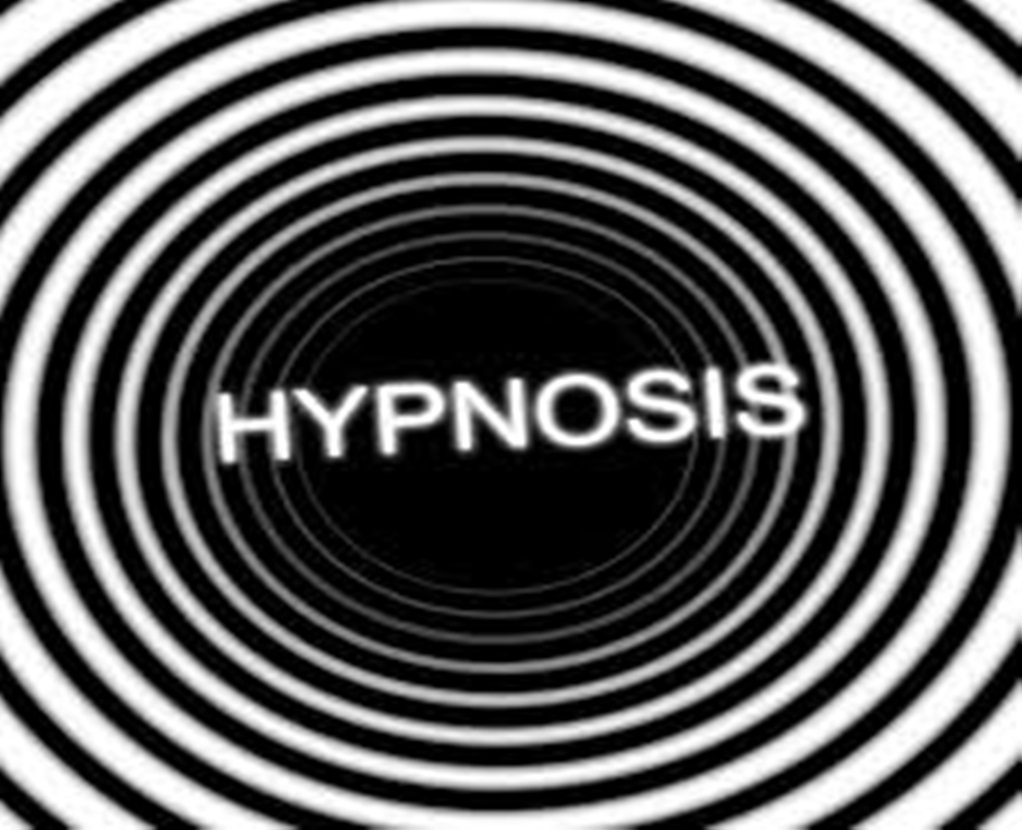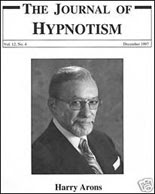|
|
||||||||||||||||
|
HOW HYPNOSIS WORKS
(Presumably)
The Science of the Brain Scientists and researchers have worked for many decades to try to understand the workings of the human brain, arguably still the most complex computer known to man. As a result of this quest, new electronic techniques have been found to help shed light on the inner workings of the brain. One of the first techniques used to delineate and measure changes in the human brain was through the use of electroencephalography (EEG) to monitor and measure actual brain waves. Out of this research, various brain states were discovered. The graph at left associates the known brain state measurements of cycles per second (CPS) with the most reasonable proposition for consciousness. These measurements infer that there are indeed various levels of consciousness. The foremost level appears to be a heightened or excited sense of consciousness, called hyperconscious. (gamma) A normal, non-heightened sense would be basic consciousness. (beta) Between the states of conscious and unconscious there is semiconscious (alpha), which is possibly the easiest and best way to assess this sate. (semconcsious) The subconscious (theta) is beneath the conscious. It could very well be thought of as a support foundation for our conscious state. The lowest state would be the lack of consciousness, known as unconscious (delta). This is essentially the stripped down principal foundation of the brain. |
Links Intro to Conscious, Subconscious & Unconscious Mind (YouTube) What Brain Wave States Are Associated With Hypnosis? Brain Waves: Delta, Theta, Alpha and Gamma Conscious vs Subconscious (YouTube) How Hypnosis Works (YouTube) How the Brain Works (YouTube) The Subconscious Mind (YouTube) The Stanford Hypnosis Study (YouTube) Top Hypnotists Study How to Affect Your Brain States Psychoanalytic Therapy: Unconscious vs. Subconscious Mind How The Subconscious Mind Works - Insights Into The Subconscious 5 Types of Brain Waves Frequencies: Gamma, Beta, Alpha, Theta, Delta
|
|||||||||||||||
|
It should also be noted that scientists have discovered other brain states as well. One is known as Mu waves or mu rhythms, which originate from the motor cortex and repeat at a frequency of 7.5–12.5 Hz. (They are most prominent from 9-11 Hz) Mu patterns have been measured by electroencephalography (EEG), magnetoencephalography (MEG), as well as electrocorticography (ECoG). Mu waves are thought to reside between the conscious beta and unconscious alpha states, so there very well may be a roll or connection in the formation of trance. They are said to be most prominent when the body is physically at rest. They are thought to be suppressed when a person performs a motor action. Scientists are just now beginning to explore the Mu wave. (See also: Wikipedia) The other discovery by researchers is
extremely low wave activity that is under the delta level, called
infra-low waves. They are thought to operate from 0.1 to 0.5 Hz. Not
much has been written about this wave. The first question would be if
two-way conversation is possible through the Inis Simpson protocol. More
research will surely be forthcoming on this latest discovery.
Another Way to Look at Consciousness vs. Trance When it comes to hypnosis, many people errantly think that hypnosis itself is an effect, when in all reality it is not. It is a mechanism. Trance is the effect. Hypnosis is merely the vehicle that is used to achieve trance. This is a significant distinction that very few understand or realize. Hypnosis is merely a process that is used to achieve a state of trance in the brain. At first blush, the difference between consciousness and unconscious would appear to be a wholly dichotomous distinction, as in black and white or night and day, but in all reality, the levels of human consciousness might be viewed as a gradable state, moving from one level to the next, up or down, very much like a rheostat does with an electrical current. It would seem a reasonable analogy to make since each brain level is correlated to a particular hertz (Hz) frequency. With that said, let's look at hypnosis as a tool, like an actual rheostat for the brain. In the electrical world, a rheostat (dimmer switch) varies electrical flow through a circuit by adding resistance to it. Hypnosis is very similar in that it varies brain activity and the amount of brain cycles per second. By regulating brain Hz (CPS), trance is effected. A subject is able to move into and through various levels of consciousness - from a conscious state to a subconscious state - from beta to alpha, from alpha to theta, and then theta to delta. Hypnosis can be used to turn the level of conscious awareness down or turn it back up, just like with the rheostat. The bulb can shine brightly or be brought down in luminance. It can also be on or off. As is the case with a rheostat and electricity, so it also appears with hypnosis and consciousness. What seems apparent is a slowing of the conscious part of the brain under hypnosis, to descend from a conscious state, to either a semiconscious, subconscious or unconscious state. It would very much appear that modulating brain frequency down or up is the key to trance and consciousness. The deepest unconscious state was originally thought to be an Esdaile state, the lowest known brain state before Infra-low was discovered. The Esdaile state was named after Dr. James Esdaile who used it quite often in place of anesthesia - for surgeries, dental procedures, and even child birth. As mentioned, researchers now have an even deeper state to reconcile, the new Infra-Low state which is currently being researched. Not much is known about this state, except for the fact that it is indeed under the Esdaile state, which speaks volumes regarding its level of trance / consciousness. One of the most remarkable things about the brain is the fact that even in its worst state it is still capable of limited operation. Even in an unconscious state, there are autonomous functions being executed by the brain, such as the autonomic nervous system, the immune system, your heartbeat and breathing, and even simple digestion. Hypnotizability There are some who say that only a certain amount of people can be hypnotized, but the jury is still out on that debate due to the limited scope of the actual trials and also the limited number of trials. At present, it has to be assumed that pretty much anyone can be hypnotized, with those who are less susceptible as part of a very small minority. On the other hand, there are those who can be hypnotized more easily than others and science seems to imply that it is so. There are those who are identified with a larger brain rostrum size (up to 32% larger) which reportedly is supposed to give these people a heightened ability to focus, which some say makes them easier to hypnotize. People who are very easy to hypnotize are categorized as somnambulistic. (If you're a sleepwalker, you're more than likely somnambulistic.) Increasing Hypnotizability Studies have shown that a person's level of hypnotizability can actually be increased, making them more susceptible to hypnosis. A 2018 study headed by professor Max Colheart, was able to increase the hypnotizability of some people through the use of Transcranial Magnetic Stimulation (TMS). It was found that this disrupted activity in part of the brain, increasing the subject's ability to be hypnotized. Communication in Deep Trance Researchers have also found ways to actually communicate with the brain in a deep delta (Esdaile) state using the Ines Simpson protocol. At this level the brain is thought to be in an infantile state. This is the best state for deep hypnotic programming. To be able to communicate with a subject at such a deep level was thought to be a major break through in hypnosis. (It is not known yet if this will also work for the Infra-Low level.) Technological Inroads Much is now being learned about the human brain, thanks in large part to technological progress. High-tech innovations are now starting to make inroads on brain diagnosis and electrical measurement. The EEG is still a popular tool for hypnosis researchers [ example 2 | example 3 ], but new technologies have come along since the advent of the EEG.
One new high-tech method of measuring brain activity is
through
magnetoencephalography (MEG), a neuroimaging process that measures the
weak magnetic fields emitted by neurons. This technique can be used
for mapping brain activity by using extremely sensitive magnetometers to
record the magnetic fields produced by naturally occurring electrical
currents in the brain. The fact is, thanks to the use of MRI, physical changes to the brain under hypnosis have now been recognized and documented. This has been a very significant scientific breakthrough because it provides evidence to validate the effect of hypnosis on the brain. Many studies have already taken place, with more studies being planned. These MRI studies come at a much more significant cost, compared with other techniques, such as electroencephalography, however, the yield of substantial, significant data has already proven the potential of MRI to be quite revealing and very rewarding. Summary The brain is indeed the most remarkable computer known to mankind. An entirely bioelectric system of cognitive thought and memory storage, complete with an intuitive OS that learns on its own and with the capability for organic growth. That's pretty amazing. Despite all of our technological advances of the last 200 years, we're still a very long way from being able to create a self sustaining biological computer. The human mind is indeed a wonder to behold and we are still trying to figure out how it all works, in the 21st century. So, to think that we have a complete understanding of trance on the human mind at this point of our evolution is a premature supposition, at its very best. Perhaps someday soon though, either through the application of MRI, or an as yet unknown or unapplied technology, we will eventually develop the ability to further define and qualify the distinction of human brain states, but also pinpoint their actual origin, giving us that long sought Eureka moment, where we finally have a more detailed understanding of the brain, but also trance and its human effects. [ NOTE: Click on all the images above for a larger picture. ]
SURPRISE! HYPNOSIS COMES IN MANY LEVELS! The reason why there is so much confusion over hypnosis is because most people think there is only one level of hypnosis. They errantly think that being "hypnotized" is the same for everyone - and from every hypnotist - but the reality is, there are many variables to being hypnotized, such as the subject's predisposition (somnambulist or not), as well as the skill-level and expertise of the hypnotist. The most prominent distinction to understand is that there are many levels of hypnosis. To be more accurate, there are many levels of trance. Most people only experience Alpha and Theta level when it comes to hypnosis trance because these are the common levels that most all hypnotherapists work from. There are, however, much deeper levels of hypnosis that they will never venture toward, primarily because such a deep trance state is not required for the therapeutic modalities they offer. The exception to this is the medical hypnotherapist who uses deep hypnosis trance primarily for analgesic/anesthetic purposes during medical procedures. Sadly, these much deeper levels of hypnosis are also predatory territory for the deviant, unscrupulous hypnotist. These extremely deeper levels of trance, Delta and Infra-Low, are primarily where the criminal hypnotist operates to subdue his victims. Those that have only experienced the lighter levels of trance, such as Alpha and Theta, have no concept of what it is like to be taken much deeper into Delta, where you can no longer speak, move or have a will of your own. Post-hypnotic suggestions are easily accepted in Delta and lower. The newly discovered Infra-low state is thought to be an infantile state, almost like a blank conscious-less state, where the subject is most vulnerable of all to deep post hypnotic suggestion. Here is what most people miss in assessing the true capabilities of hypnosis. (see graphic below) So, for someone to say they've been hypnotized and they now know what it's all about, a statement such as that is quite disingenuous, unless they've truly been to the much deeper levels of trance. It's like saying they've tasted ice cream, yet the only flavor they've ever known about was vanilla. There is so much more to hypnosis trance than most people are aware, including for the therapists. The bottom line is, there needs to be a better of understanding of hypnosis and trance for all. Here's to all who are diligently working toward that end. |
||||||||||||||||
|
|
||||||||||||||||

There are three brain states that are perfect for trance, known as alpha, theta, and delta, with alpha being the lightest and delta the strongest. Out of those three primary states, it's not a stretch to surmise that there are indeed various degrees of each state, from lesser to strongest. This would thus support the basis behind the numerous measured hypnosis scales, which technically should be thought of as measuring the amount or degree of trance.
The difference between these various brain states, versus the numerous levels of "hypnosis" that have been proposed over the years through a multitude of various measurement scales, seems to be an as yet unreconciled issue in assessing this phenomenon and its associated depths of trance. A consensus opinion has yet to be achieved, however, science is starting to catch up. The challenge has always been to define and articulate each known level of trance into as many notable degrees or states that can be recognized and validated, such as light-alpha, medium-alpha, or strong-alpha. Looking at the table above, it's easy to see how there could be a multitude of trance levels. The question is, how to note and delineate levels of trance. How much difference is there between heavy-alpha and light-theta? How do we properly measure trance? The problem that exists today is that in the search for the best measurement system for trance, we now have far too many scales to consider. This keeps trance from being measured in a uniform manner by scientists and researchers. The truth of the matter is this... for hypnosis to move forward in a recognized scientifically accepted fashion, there needs to be only one hypnosis scale that is agreed upon by all, to measure the effects of trance with a consistent accuracy that can be easily compared side by side with other clinical trials.
Due to the widespread misunderstanding regarding hypnosis, there are many hypnotic scales of reference in debate to this day, so the question still remains as to "what are all the stages and degrees of hypnosis." Unfortunately, this is still as yet undefined territory and very much up for prime debate.
One thing is certain, for the hypnosis field to flourish, a recognized and well understood industry standard needs to be adopted. It is absolutely imperative that a standardized scale be put in place in order to move the industry forward and further into the scientific realm. Here are but just some of the hypnotic
scales that have been introduced over the years. (More
here)
One of the most often used hypnosis scales, perhaps because it is one of the easiest to understand, is the Arons scale, developed by hypnotist Harry Arons.
Harry Arons was a true pioneer and major contributor in the advancement of hypnosis. He was noted for his nationwide training courses, but also for helping hypnosis gain a significant foothold within the medical community. An author on the subject, Arons is said to have trained thousands of medical professionals, as well as hundreds of law enforcement professionals over four decades. The Arons depth scale is still used to this day.
Stage 2:
Light trance.
A much more relaxed state. Muscle and limb
catalepsy. Critical reasoning starts to become impaired in this state.
(alpha-theta)
Stage 3:
Medium trance.
All of the above, plus... control of the entire muscular
system. The inability to articulate a number, walk or even move. Partial
analgesia is also present. (theta)
Stage 4:
Profound
trance.
All of the above, plus... amnesic stage. Subjects can
forget their name, phone number, address and other personal items. Analgesia
is present. The ability to feel touch, without discomfort. (theta-delta)
Stage 5: Somnambulism. All of the above, plus...
complete anesthesia. The inability to feel touch or discomfort.
Hallucinations can manifest. (delta) Stage 6: Profound Somnambulism. All of the above, plus... a very deep coma-like trance. The perfect state for mental conditioning and/or personal behavior programming. Complete subject control and with total compliance. This is the Esdaile state. (delta) |
||||||||||||||||

